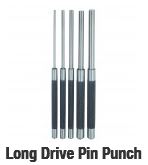| Author | Message | ||
Paul White Experienced User Username: pjcwhite Post Number: 17 Registered: 2-2015 |
Hi, are there any instructions on how to depressurise an SS2 accumulator sphere prior to transportation ? Thanks Paul | ||
Brian Vogel Grand Master Username: guyslp Post Number: 1501 Registered: 6-2009 |
Paul, It's generally not necessary to depressurize the accumulator spheres to ship them, particularly if they're going by ground transport. The spheres for the SZ cars are routinely shipped across the globe fully charged. The above being said, the official tool for depressurizing the spheres looks very much like the charge port cap with a wedge cut off the top of the cap and a pin attached to the center that pushes open the metal ball bearing that acts as the primary valve as it's screwed on. They're hard to come by, although you could have one made. However, a simpler solution is to use a pin punch:  You do want to be certain that you're not looking directly in to the port when you do this in case there's crud (even a tiny fleck of something) that gets ejected when the valve is opened. You have to give a firm tap with a hammer to force the valve open and most times you keep doing this repeatedly until you've depressurized the accumulator. If they're anywhere near to fully charged the hiss that you get is startling when you first begin the process. This was how sphere depressurization was demonstrated at the hydraulics seminar I took at the RROC-US/RRF HQ back in 2007. You also don't want to have the charge port aimed toward you if the plastic/nylon/PTFE ball secondary seal is wedged in the port and you need to extract it. Brian | ||
Robert Noel Reddington Prolific User Username: bob_uk Post Number: 282 Registered: 5-2015 |
Planes and ships have even bigger nitrogen accumulators in their hydraulic systems. Road transport also use spheres. So I never understood why they are dangerous to transport. A sphere of that wall thickness ratio to diameter is very strong. I reckon it would take lots of force to break it. Tons of force. These spheres don't burst and are tested to 2800 psi every time the car is started. The nitrogen pressure is 1000psi. Then judging by the thickness of the steel used 6000 psi is possible maybe even 20,000 psi before it bursts. In a fire the diaphragm will rupture and the nitrogen will vent out of the pepper pot holes. Every time I drive my car I am transporting 2 spheres. Unfortunately rules are rules and if the carrier says discharged then you are stuck with it. Note lying about hazardous goods to a carrier could be a criminal offence. | ||
Paul White Experienced User Username: pjcwhite Post Number: 18 Registered: 2-2015 |
Thanks Brian and Bob. I'll get a long drive pin punch and give it a go. I agree they're obviously robust and unlikely to blow up but rules is rules. cheers Paul | ||
Brian Vogel Grand Master Username: guyslp Post Number: 1509 Registered: 6-2009 |
Paul, Just curious but where are you and what shipper are you using? The fluid that oozes from these things (and the need to contain it) has always seemed far more pressing to me than the nitrogen charge. Definitely put them in large ziplock bags when you send them. I know that there are people who rebuild these in the US who ship them charged (and I very much doubt that anyone is violating shipping rules). Also, you don't need the long drive style pin punch to let the nitrogen out. A regular pin punch of a narrow enough diameter is way more than long enough to reach the metal ball bearing inside the charge port with length to spare. Brian | ||
Paul White Experienced User Username: pjcwhite Post Number: 19 Registered: 2-2015 |
Hi Brian, I'm in Melbourne Australia. The refurbished valve and new aftermarket sphere I got was from Flying Spares in the UK. Interestingly enough the new sphere apparently came charged and flew as it only took 5 days to arrive via UPS. I need to call FS when the old valve and sphere is ready for despatch and they will arrange a courier. I assume UPS again. FS have supplied Ziploc bags, zip ties and labels for the returned parts. As you say, best to keep all that fluid from leaking out. cheers Paul | ||
Paul White Experienced User Username: pjcwhite Post Number: 20 Registered: 2-2015 |
Depressurisation successfully completed at the weekend. Unscrewed the spheres from the valves, kitted myself out with ear protectors and safety glasses to cope with the expected surge of nitrogen, violent hiss and distinct possibility of the punch being launched into orbit. Not as exciting as I expected. Both spheres were obviously very low on charge as they didn't hiss much at all before they were completely empty  |